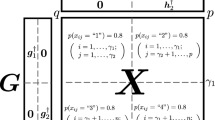Summary
In this paper we propose a new strategy to study a dependence problem among qualitative variables, based upon 1) a generalization of the covariance criterion (Tucker, 1958), 2) a monotone regression in order to preserve the original ordering of categories on the axis of maximal covariance, and 3) the Partial Least Squares (PLS) approach (Wold, 1966) to compute the remaining axes. From a practical point of view, the use of a complete ordering of predictors can be considered as a way to extract more interpretable information Under the completer order constraint of the scores, different techniques have been proposed in literature, specifically within the context of optimal scaling (Nishisato, 1980; Nishisato and Arri, 1975).
Similar content being viewed by others
References
AGRESTI, A. (1990),Analysis of Categorical Data. Wiley series.
AMENTA, P. and LOMBARDO, R. (1993), Estimation of the Stability of Constraind Factorial Analysis by Permutation Tests in Three-way data sets.Sixth International Symposium on Applied Stochastic Models and Data Analysis, Chania, Greece, May 3–6.
Bockenholt, U. andBockenholt, I. (1990), Canonical Analysis of Contingency tables with linear constraints.Psychometrika, 55 (4), 633–639.
Bro, R. (1997), Multiway Calibration Multilinear PLS.Journal of Chemometrics, 10, 47–61.
Cazes, P. (1997), Adaptation de la Règression PLS au cas de la Règression après analyse des Correspondence Multiples.Revue de Statistique Appliquee, 2, pp. 89–99.
Chessel, D. andHanafi, M. (1996), Analyse de la Co-inertie de K nuages de Points.Revue de Statistique Appliquèe, XLIV (2), 35–60.
D’Ambra, L. andLauro, N. C. (1989), Non symetrical analysis of three-way contingency tables. InMultiway Data Analysis (eds. R. Coppi and S. Coppi and S. Bolasco). Amsterdam: Elsevier.
D’AMBRA, L., SABATIER, R. and AMENTA, P. (1998), Analisi Fattoriale delle Matricia a trevie: Sintesi e Nuovi Approcci. InAtti della Riunione scientifica della SIS XXXIX.
D’AMBRA, L., LOMBARDO R. and AMENTA, P. (2000), Joint Non Symmetric Correspondence Analysis with ordered categories. Submitted.
De Jong, S. (1993), SIMPLS: An alternative approach to partial least squares regression.Chemiometrics and Intelligent Laboratory Systems, 18, 251–263.
DURAND, J.-F., ROMAN, S. and VIVIEN, M. (1998), Guide d’utilisation de la Régression Partial Least Squares linéaires sous Splus.Rapport technique Groupe de Biostatistique et d’Analyse des Systémes, INRA, Montpellier, no. 98-06.
Escoufier, Y. (1985), Objectifs et procédure de l’analyse conjointe de plusieurs tableaux de données.Stat. Anal. Don., 10, pp. 1–10.
Gifi, A. (1990). Non Linear multivariate analysis. Chichester: Wiley.
Goodman, L. andKruskal, N. C. (1954), Measures of Association for cross classifications.JASA, 49, 732–764.
La Fosse, R. (1997), Concordance d’un tableau avec k tableaux, definition de k.ples synthetiques.Revue de Statistique Appliquèe, XLV (4), 111–126.
LECLERC, A. (1975), L’Analyse des Correspondences sur Juxtaposition de Tableax de Contingence.Revue de Statistique Appliquèe, XXIII (3).
Nishisato S. (1980),Analysis of categorical data: Dual Scaling and its applications. University of Toronto Press, XLIII (1), 7–63.
Nishisato, S. andArri, P. S. (1975), Non-linear Programming approach to optimal scaling of partially ordered categories.Psychometrika, 40, 525–548.
Pearson, M. (1900), On lines and planes of closest fit to systems of points in space.Phil. Mag., 2 (6), 559–572.
Ramsay, J. O. (1988), Monotone Regression Spline in Action.Statistical Science, 3 (4), 425–461.
Tenenhaus, M. (1995), Régression PLS et applications.Revue de Statistique Appliquée. XLIII (1), 7–63.
Tenenhaus, M. (1998),La Régression PLS, Thèorie et Pratique. Paris: Editions Technip.
Tenenhaus, M. (1999), L’Approche PLS,Revue de Statistique Appliquée, XLVII (2), 5–40.
Tibshirani, R. andKnights, K. (1999), Model search and inference by bootstrap «bumping».Journal of Computational and graphical Statistics 8, 671–686.
Wold, H. (1975), Estimation of principal components and related models by iterative least squares. InMultivariate Analysis (ed. P. R. Krishnaiah), 391–420. New York: Academic Press.
Author information
Authors and Affiliations
Corresponding author
Rights and permissions
About this article
Cite this article
D’Ambra, L., Lombardo, R. & Amenta, P. Multivariate co-inertia analysis for qualitative data by partial least squares. J. Ital. Statist. Soc. 9, 23–37 (2000). https://doi.org/10.1007/BF03178956
Issue Date:
DOI: https://doi.org/10.1007/BF03178956




